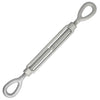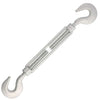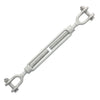Understanding Turnbuckle Safety: Essential OSHA and Federal Regulations
Turnbuckles are crucial tools in many rigging applications, used for adjusting the tension and length of cables, ropes, and other tensioning systems. Ensuring they are safe to use requires adherence to specific Occupational Safety and Health Administration (OSHA) and federal regulations. This guide provides an overview of the essential safety rules and standards you need to follow when using turnbuckles.
OSHA Regulations for Turnbuckles
Inspection and Maintenance (OSHA Standard 1910.184)
Regular inspections and proper maintenance are vital for securing the safety and longevity of turnbuckles:
- Regular Inspections: Turnbuckles should be inspected before each use and periodically during their use. Look for signs of wear, deformation, and corrosion.
- Defective Turnbuckles: Any turnbuckles found to be damaged, deformed, or showing excessive wear should be removed from service immediately.
Load Capacity
Verifying turnbuckles are not overloaded is critical for safe operation:
- Rated Load: Always adhere to the working load limit (WLL) specified by the manufacturer. Overloading can lead to catastrophic failures.
Secure Attachments
Proper installation and secure attachments are necessary to prevent accidents:
- Proper Installation: Make sure turnbuckles are installed correctly, with threads fully engaged and end fittings securely attached.
- Safety Pins or Cotter Pins: For turnbuckles with jaw fittings, always use the provided pins or cotter pins to secure the connection and prevent accidental disconnection.
Federal Regulations and Standards
Conformance to Specifications
Turnbuckles must conform to specific federal specifications to uphold quality and safety standards:
- U.S. Federal Specification FF-T-791B: This specification outlines the requirements for material strength, dimensions, and load capacity of turnbuckles. Maintaining compliance guarantees that the turnbuckles meet high safety standards.
Material Standards
Choosing the right material for your turnbuckles is essential for their performance and durability:
- Galvanized Steel: Hot-dipped galvanized turnbuckles offer excellent corrosion resistance, making them suitable for general use in various environments.
- Stainless Steel: Type 316 marine-grade stainless steel turnbuckles provide superior corrosion resistance and are unmatched for marine and highly corrosive environments.
Proper Use and Application
Selecting the appropriate turnbuckle type and ensuring correct usage is crucial for safety:
- Appropriate End Fittings: Use the right type of end fittings (eye, jaw, hook) based on the specific application to secure safe connections.
- Avoid Overloading: Never exceed the turnbuckle’s rated load capacity to prevent potential failure.
Training and Competency
Ensuring that personnel are adequately trained and competent in using turnbuckles is a key aspect of safety:
- User Training: Personnel should be properly trained in the correct use, inspection, and maintenance of turnbuckles.
- Documentation and Records: Maintain accurate records of inspections, maintenance, and any incidents involving turnbuckles to track their condition and usage history.
Recommended Turnbuckles from E-Rigging
To help you find the right turnbuckles for your needs, we recommend the following products available at E-Rigging:
- Jaw x Jaw Turnbuckle (SKU: 51501061)
- Eye x Eye Turnbuckle (SKU: 51503061)
- Hook x Hook Turnbuckle (SKU: 51501061)
Adhering to OSHA and federal regulations is essential for the safe and effective use of turnbuckles. By following these guidelines, you can ensure the safety of your rigging operations and prevent accidents. For more detailed information, refer to OSHA’s general industry standards and specific federal specifications relevant to rigging hardware.
By understanding and implementing these safety regulations, you can maintain a safe working environment and uphold the longevity and reliability of your turnbuckles. Visit E-Rigging to explore our comprehensive range of high-quality turnbuckles and rigging equipment.






